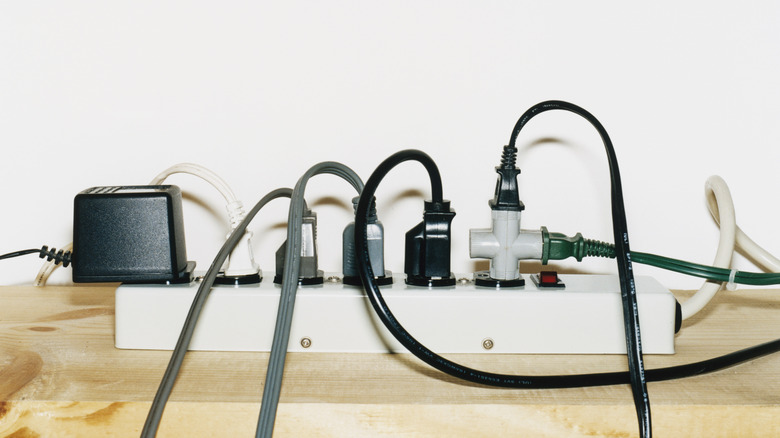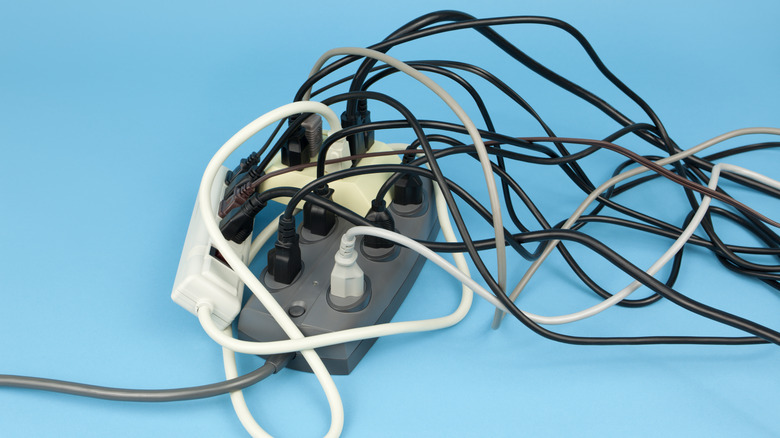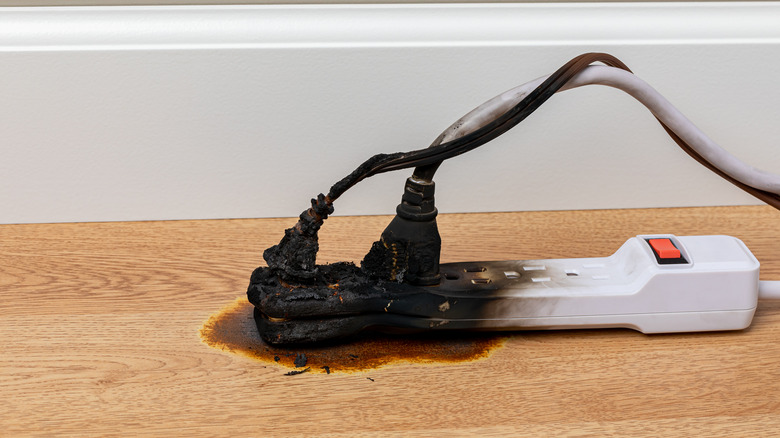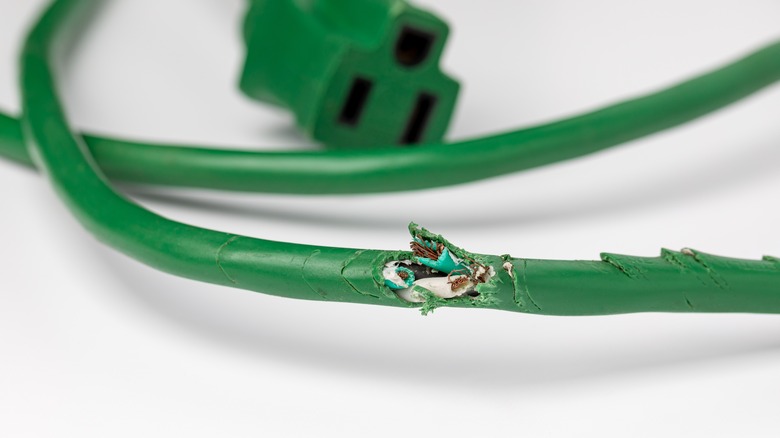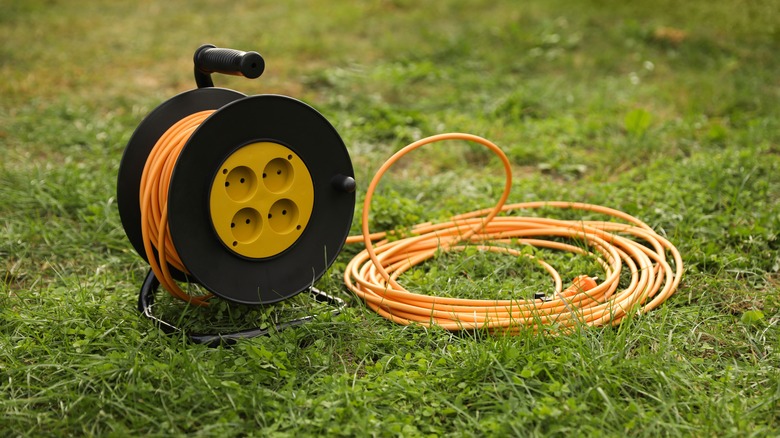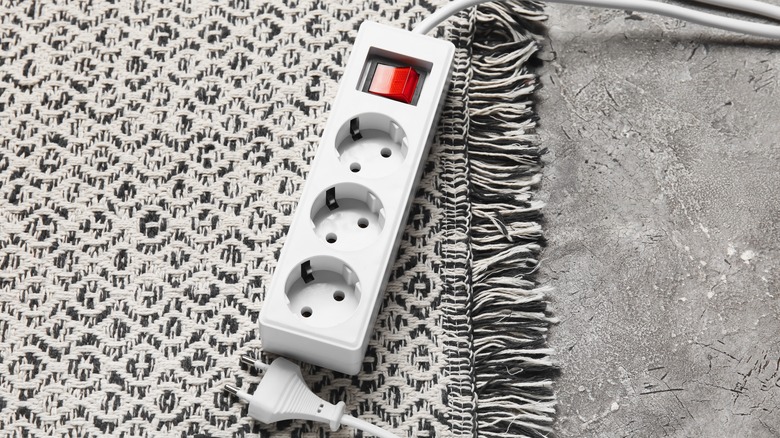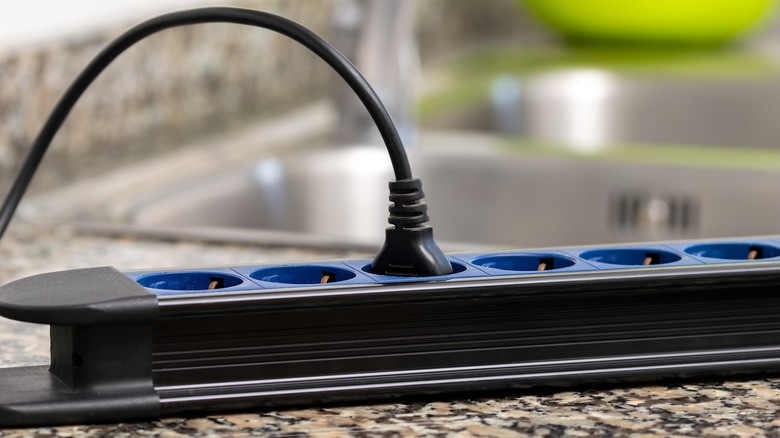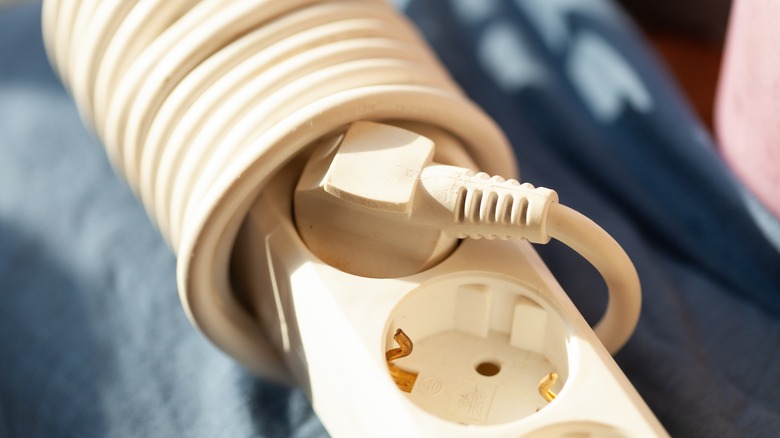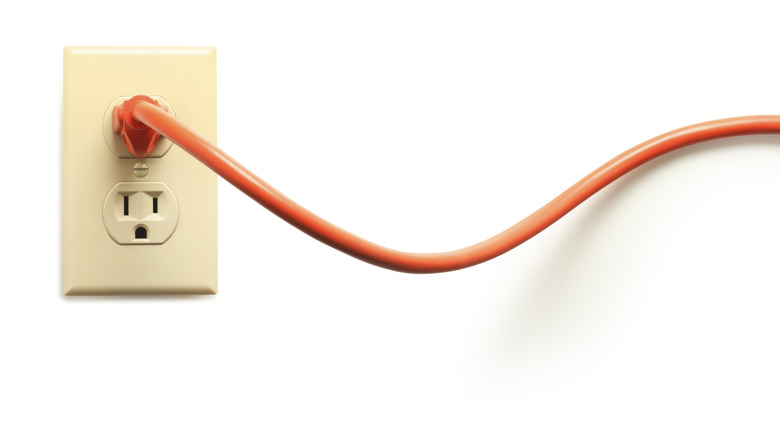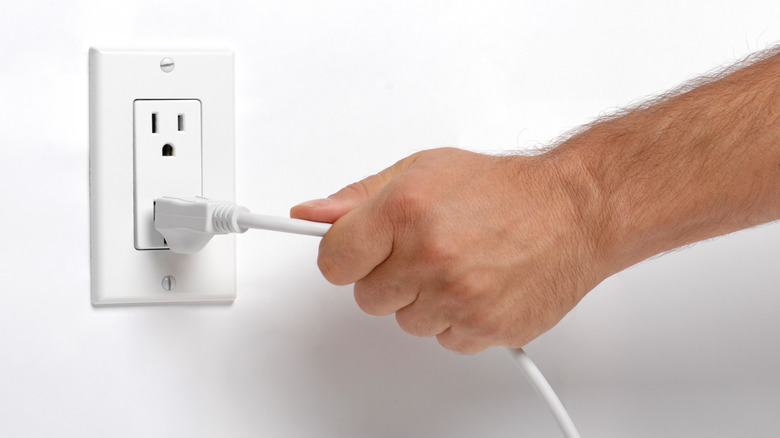10 Common Extension Cord Mistakes You Should Avoid
We may receive a commission on purchases made from links.
When moving into a new house or apartment, one of the first things you should do is check where all the outlets are. It'll help guide you as to where good locations for your television set and other appliances would be. However, you might still find yourself lacking a few places to plug in electronics, which will necessitate a few carefully placed extension cords.
There's a good chance you already have some cords around your abode. You may even have a box of them in a drawer somewhere just in case you ever need something extra. They're invaluable to numerous households, and while it seems simple enough to just plug whatever you need in, there are still some troublesome mistakes you might be making.
What follows is a list of common extension cord mistakes, some of which you may have never considered before. It's possible you've been making some of these errors for years without incident, but it's always a good idea to change habits. It may have been fine for a while, but you should always take steps to reduce the danger in your home and learn how to use extension cords properly.
Don't overload your extension cord
An outlet may only have two sockets to plug in two appliances. With an extension cord, you could theoretically plug in as many as six or eight. However, just because a power strip comes with a lot more sockets doesn't mean you necessarily need to (or should) use them all.
Extension cords come with specific amperages (A) that indicate how much power they can handle. You'll usually find this on the tag that came with the strip when you purchased it, or on the strip itself. Many modern cords are rated for 13A, but if you're pulling out an older cord from storage, double-check — it might only handle 10A or less.
A 13A cord is generally fine if you only want to plug in a bunch of smaller devices, like clocks and lamps. But if you're still using corded power tools instead of cordless ones, you'll need to be more careful. Large-capacity tools like table saws, angle grinders, and sanders shouldn't be plugged into extension cords. These should always go directly into a wall socket.
Don't daisy chain extension cords
This extension cord don't is essentially about avoiding overloading. Daisy chaining is the act of plugging one extension cord into another so that you can make it longer. This is often done because the outlet is still too far away, even with a single strip, from where you need the appliance placed. The issue here is that this creates a risk of overloading the circuit, especially if you're using cords of varying amperages. This increases the risk of a fire breaking out or, at the very least, the cords failing.
What you should do instead is plan ahead more thoroughly — meaning you should simply purchase a longer cord if you need it to go further. While most cords are only a few feet in length, others can be as long as 100 feet, although these are usually designed for outdoor use. If you need a longer cord for indoor use, you might also want to consider moving whatever you're plugging in closer to the outlet. Even if it messes with the feng shui of the room, it's better than creating a fire hazard.
Don't use a damaged extension cord
This tip is mainly for when you take an extension cord out of storage after not using it for a while. It's recommended to inspect it thoroughly to ensure there are no signs of damage, like fraying. You also need to be wary if the cord got wet at any point, like if you kept it in a garage that flooded at some point. In these cases, it's best to simply throw the cord away because something could easily go wrong with the wiring inside.
In the event you need to put an extension cord away for a while, you should take the time to store it properly. Don't just toss it into a box with a bunch of other random cords, plugs, and batteries. An essential gadget you should have in your garage is a hand-cranked cord organizer, like this one from Amazon. This keeps any cords out of the way and properly coiled so the wires inside don't become kinked. And if it's hanging from a wall, there's a reduced chance any flooding would cause damage. The best way to avoid using a damaged extension cord is to prevent damage in the first place.
Don't forget to check if your extension cord is for indoor or outdoor use
As has already been stated, there are outdoor and indoor extension cords, and you want to make sure you get the right one for wherever it'll most commonly be used. This is due to the fact that indoor cords aren't designed to withstand the elements. Outdoor cords are heavier-duty; they can sometimes withstand being driven over and handle some flying debris (not that we'd recommend doing that all the time).
It's paramount to know how to pick the right extension cord for your needs, and the best way to do this is to read the label to see what rating it has. Extension cord labels come with various designations to indicate how they should be used. "S" is meant for indoor use, while "W" signifies outdoor applications. Other letters can provide additional information, such as "T" informing you the cord is made out of vinyl thermoplastic, which is generally recommended for outdoors, especially construction sites since it can withstand rockier terrain.
Meanwhile, "O" indicates a cord is suitable for contact with oil, meaning it's better for garages where someone might work on cars. Know your letters so that you don't wind up having to return the cord after buying it.
Don't run your extension cord under a rug
No one wants a bunch of unsightly cords running throughout their home. In an attempt to put the cord out of sight and out of mind, some homeowners might place it underneath a rug to reach its outlet, but that's a big mistake. Even if you haven't plugged in too many appliances, the cord can still heat up. If it's trapped under a rug, there's nowhere for the heat to disperse, which increases the risk of a fire. Even ignoring the fire hazard, a cord still bumps up the carpet a bit and could trip someone if they're not careful. You could even wind up damaging the cord by accidentally placing furniture on top of it.
For anyone who doesn't want cords running throughout their floor, the best advice is to ensure they hug the wall. An easy trick for hiding wires from a mounted TV is to use a raceway, which acts as a conduit to conceal wiring. The same device could likely be used for extension cords, but you can also use plastic trunking or adhesive cord clips (we like these from Amazon). The best part about cord clips is that when you need to remove them, they shouldn't damage the wall's paint, making them a great choice for renters with wires all over the place.
Don't tape extension cord to wall
The name of the game when it comes to extension cord safety is ensuring it can adequately disperse heat. You don't want to place anything over them that would prevent that, including tape. Anyone lacking adhesive cord clips or another approved tool might think they can simply tape the cord against a wall, and that'll do the trick. The problem here, much like putting a rug over the cord, is that it still prevents heat from dissipating correctly.
Another shortcut some folks might try is stapling or nailing the extension cord into place so that it stays near a wall. The problem here is that staples and nails can cut into the cord, leading to fraying. Any exposed wiring increases the risk of a spark, which could result in a fire. Various cord organizers are specifically designed not to tamper with the cord's insulation, allowing heat to disperse while maintaining the cord's integrity.
Don't plug in larger appliances
No matter what, you should avoid plugging larger appliances like refrigerators and washing machines into an extension cord. These appliances typically require much higher power thresholds at all times. Refrigerators constantly need to draw power to keep food cold. Unlike a lamp that might sit idle, a fridge requires a dedicated wall outlet.
Other appliances may not be in use at all times, but when they are, they draw a significant amount of power. This includes microwave ovens, coffee makers, slow cookers, hair dryers, and space heaters. In general, it's a good idea to keep power strips out of the kitchen entirely. With a sink and dishwasher in the vicinity, there's always a chance of flooding, and you don't want to risk an extension cord getting wet, especially when it's plugged in. The same holds true for the bathroom, where you might consider using an extension cord for a hair dryer or curling iron.
For all of these devices, your best bet is to plug them into an outlet. If you don't have enough outlets in the kitchen for all your appliances, consider keeping certain items unplugged when not in use. For example, you probably don't need your slow cooker plugged in all the time, so unplug something else to make room when you need to use it.
Don't bend or coil an extension cord when in use
It's understandable to coil your extension cord when it's not in use to save space in storage. However, when you go to plug it in, you want to ensure the cable isn't constricted. You shouldn't bend or coil the cord while it's in use, even if you think it'll help save space, because this increases the risk of overheating. The wires inside the cord carry significant electrical currents that need to dissipate heat so the cord doesn't get too hot. If it's constricted, all of that heat gets trapped, which can cause the insulation to wear down and potentially lead to a fire.
While the house's circuit breaker might trip to prevent something catastrophic, you don't want to rely on that as your safety measure. It's best to completely uncoil an extension cord before using it. This is especially important for longer cords, even if you don't need the entire length unraveled to reach the outlet. Uncoiling it ensures adequate air circulation to get rid of excess heat.
Don't remove the third prong
An easy way to spot old technology in a home or apartment is the presence of two-hole power outlets. These outlets were commonplace because older technology didn't require as much electricity. In recent decades, many outlets have been replaced with three-hole models designed for appliances with a grounding prong. This is the big third prong at the bottom that's designed to give electricity a safer path to the ground. In the event of a malfunction, it helps protect you and your devices from sudden surges. Under no circumstances should you ever attempt to remove this third prong to make an extension cord fit into a two-hole outlet.
Outlets act as conduits for massive amounts of electricity, and the grounding prong is essential for safety. This also applies to anything you might charge with the cord, especially if it's an older device. While prong adapters are available, they're generally not recommended. If you have a lot of two-hole outlets in your home, you might want to consult with an electrician about getting your systems more up-to-date. This can help ensure you don't put too much strain on the system or compromise safety.
Don't pull out an extension cord by the cord
Whether you're moving apartments or just trying to free up some space, you'll need to remove an extension cord sooner or later. When that day comes, it may seem simple enough to tug on the cord to remove it from the outlet, especially if it's tucked away somewhere and you can't quite reach the plug itself. However, you absolutely need to avoid yanking on the cord, as this creates a risk of damaging the internal wires.
The best way to remove an extension cord from an outlet is to firmly grasp the plug with dry hands. Make sure there's no moisture nearby. Then, pull the cord straight out, avoiding pulling at an angle, as this could damage the prongs or the outlet itself. If the cord doesn't come out easily, you may want to gently wiggle it before pulling it straight.
Extension cords are so commonplace that most people probably don't think twice about using them. But with a little foresight, you can ensure your cords last for years to come without posing any danger to you or your home.
